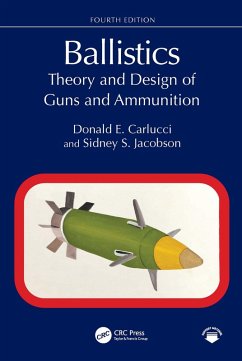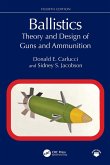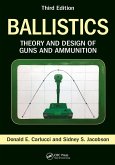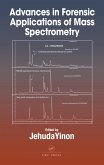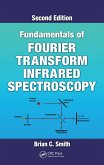Donald E. Carlucci, Sidney S. Jacobson
Ballistics (eBook, ePUB)
Theory and Design of Guns and Ammunition
175,95 €
175,95 €
inkl. MwSt.
Erscheint vor. 07.05.25

88 °P sammeln
175,95 €
Als Download kaufen

175,95 €
inkl. MwSt.
Erscheint vor. 07.05.25

88 °P sammeln
Jetzt verschenken
Alle Infos zum eBook verschenken
175,95 €
inkl. MwSt.
Erscheint vor. 07.05.25
Alle Infos zum eBook verschenken

88 °P sammeln
Unser Service für Vorbesteller - Ihr Vorteil ohne Risiko:
Sollten wir den Preis dieses Artikels vor dem Erscheinungsdatum senken, werden wir Ihnen den Artikel bei der Auslieferung automatisch zum günstigeren Preis berechnen.
Sollten wir den Preis dieses Artikels vor dem Erscheinungsdatum senken, werden wir Ihnen den Artikel bei der Auslieferung automatisch zum günstigeren Preis berechnen.
Donald E. Carlucci, Sidney S. Jacobson
Ballistics (eBook, ePUB)
Theory and Design of Guns and Ammunition
- Format: ePub
- Merkliste
- Auf die Merkliste
- Bewerten Bewerten
- Teilen
- Produkt teilen
- Produkterinnerung
- Produkterinnerung

Bitte loggen Sie sich zunächst in Ihr Kundenkonto ein oder registrieren Sie sich bei
bücher.de, um das eBook-Abo tolino select nutzen zu können.
Hier können Sie sich einloggen
Hier können Sie sich einloggen
Sie sind bereits eingeloggt. Klicken Sie auf 2. tolino select Abo, um fortzufahren.

Bitte loggen Sie sich zunächst in Ihr Kundenkonto ein oder registrieren Sie sich bei bücher.de, um das eBook-Abo tolino select nutzen zu können.
Ballistics examines the analytical and computational tools for predicting a weapon's behavior in terms of pressure, stress, and velocity, demonstrating their applications in ammunition and weapons design. It includes updated and revised equations, end-of-chapter problems, case studies, and practical examples.
- Geräte: eReader
- mit Kopierschutz
- eBook Hilfe
- Größe: 25.94MB
Andere Kunden interessierten sich auch für
![Ballistics (eBook, PDF) Ballistics (eBook, PDF)]() Donald E. CarlucciBallistics (eBook, PDF)175,95 €
Donald E. CarlucciBallistics (eBook, PDF)175,95 €![Whole Body Vibrations (eBook, ePUB) Whole Body Vibrations (eBook, ePUB)]() Whole Body Vibrations (eBook, ePUB)50,95 €
Whole Body Vibrations (eBook, ePUB)50,95 €![Ballistics (eBook, ePUB) Ballistics (eBook, ePUB)]() Donald E. CarlucciBallistics (eBook, ePUB)202,95 €
Donald E. CarlucciBallistics (eBook, ePUB)202,95 €![Advances in Forensic Applications of Mass Spectrometry (eBook, ePUB) Advances in Forensic Applications of Mass Spectrometry (eBook, ePUB)]() Advances in Forensic Applications of Mass Spectrometry (eBook, ePUB)249,95 €
Advances in Forensic Applications of Mass Spectrometry (eBook, ePUB)249,95 €![The Science of Soccer (eBook, ePUB) The Science of Soccer (eBook, ePUB)]() John WessonThe Science of Soccer (eBook, ePUB)24,95 €
John WessonThe Science of Soccer (eBook, ePUB)24,95 €![Fundamentals of Fourier Transform Infrared Spectroscopy (eBook, ePUB) Fundamentals of Fourier Transform Infrared Spectroscopy (eBook, ePUB)]() Brian C. SmithFundamentals of Fourier Transform Infrared Spectroscopy (eBook, ePUB)180,95 €
Brian C. SmithFundamentals of Fourier Transform Infrared Spectroscopy (eBook, ePUB)180,95 €![Workplace Drug Testing (eBook, ePUB) Workplace Drug Testing (eBook, ePUB)]() Workplace Drug Testing (eBook, ePUB)135,95 €
Workplace Drug Testing (eBook, ePUB)135,95 €-
-
-
Ballistics examines the analytical and computational tools for predicting a weapon's behavior in terms of pressure, stress, and velocity, demonstrating their applications in ammunition and weapons design. It includes updated and revised equations, end-of-chapter problems, case studies, and practical examples.
Dieser Download kann aus rechtlichen Gründen nur mit Rechnungsadresse in A, B, BG, CY, CZ, D, DK, EW, E, FIN, F, GR, HR, H, IRL, I, LT, L, LR, M, NL, PL, P, R, S, SLO, SK ausgeliefert werden.
Produktdetails
- Produktdetails
- Verlag: Taylor & Francis eBooks
- Erscheinungstermin: 7. Mai 2025
- Englisch
- ISBN-13: 9781040333358
- Artikelnr.: 73698975
- Verlag: Taylor & Francis eBooks
- Erscheinungstermin: 7. Mai 2025
- Englisch
- ISBN-13: 9781040333358
- Artikelnr.: 73698975
- Herstellerkennzeichnung Die Herstellerinformationen sind derzeit nicht verfügbar.
Donald E. Carlucci has been an engineer at the US Army Armament, Research, Development and Engineering Center, Picatinny Arsenal, Morris County, New Jersey, since May 1989. He is currently the US Army senior scientist for computational structural modeling based at Picatinny. He holds a Doctor of Philosophy degree in mechanical engineering (2002) and a Master of Engineering (mechanical) (1995) degree from the Stevens Institute of Technology, Hoboken, New Jersey. In 1987, he received his Bachelor of Science degree in mechanical engineering from the New Jersey Institute of Technology, Newark, New Jersey. Dr. Carlucci is an adjunct professor of mechanical engineering at the Stevens Institute of Technology, founding and senior member of the International Ballistics Society, and chancellor of the US Army's Armament Graduate School.
Sidney S. Jacobson was a researcher, designer, and developer of ammunition and weapons at the US Army's Picatinny Arsenal in Morris County, New Jersey, for 35 years. He rose from junior engineer through eight professional levels in research and development laboratories to become associate director for research and development at the arsenal. His specialty for most of his career was in the development of large-caliber tank munitions and cannons. Many of these weapons, such as the long rod, kinetic energy penetrators (armor-piercing fin-stabilized discarding sabot rounds), and shaped charge, cannon-fired munitions (high-explosive antitank rounds), have become standard equipment in the US Army. For these efforts and successes, he earned several awards from the army, including, in 1983, the Department of the Army Meritorious Civilian Service Medal. In 1972, he was awarded an Arsenal Educational Fellowship to study continuum mechanics at Princeton University, where he received his second master of science degree (1974). He earned a master of science degree in applied mechanics from the Stevens Institute of Technology (1958) and a bachelor of arts degree in mathematics from Brooklyn College (1951). He retired in 1986 but maintains his interest in the field through teaching, consulting, and lecturing. He holds two patents and was a licensed professional engineer in New Jersey.
Sidney S. Jacobson was a researcher, designer, and developer of ammunition and weapons at the US Army's Picatinny Arsenal in Morris County, New Jersey, for 35 years. He rose from junior engineer through eight professional levels in research and development laboratories to become associate director for research and development at the arsenal. His specialty for most of his career was in the development of large-caliber tank munitions and cannons. Many of these weapons, such as the long rod, kinetic energy penetrators (armor-piercing fin-stabilized discarding sabot rounds), and shaped charge, cannon-fired munitions (high-explosive antitank rounds), have become standard equipment in the US Army. For these efforts and successes, he earned several awards from the army, including, in 1983, the Department of the Army Meritorious Civilian Service Medal. In 1972, he was awarded an Arsenal Educational Fellowship to study continuum mechanics at Princeton University, where he received his second master of science degree (1974). He earned a master of science degree in applied mechanics from the Stevens Institute of Technology (1958) and a bachelor of arts degree in mathematics from Brooklyn College (1951). He retired in 1986 but maintains his interest in the field through teaching, consulting, and lecturing. He holds two patents and was a licensed professional engineer in New Jersey.
1. Introductory Concepts. 2. Physical Foundation of Interior Ballistics. 3.
Analytic and Computational Ballistics. 4. Ammunition Design Practice. 5.
Weapon Design Practice. 6. Recoil Arresting and Recoilless Guns. 7. Closed
Bomb Experimentation and Analysis. 8. Introductory Concepts. 9. Dynamics
Review. 10. Trajectories. 11. Linearized Aeroballistics. 12. Mass
Asymmetries. 13. Lateral Throwoff. 14. Swerve Motion. 15. Nonlinear
Aeroballistics. 16. Introductory Concepts. 17. Penetration Theories. 18.
Penetration of Homogeneous, Ductile Chromium-Nickel Steel Naval Armor by
Three Representative Designs of Nondeforming Hardened-Steel Armor-Piercing
Projectiles with Bare Noses. 19. Shock Physics. 20. Introduction to
Explosive Effects. 21. Shaped Charges. 22. Wound Ballistics. Appendix A.
Appendix B.
Analytic and Computational Ballistics. 4. Ammunition Design Practice. 5.
Weapon Design Practice. 6. Recoil Arresting and Recoilless Guns. 7. Closed
Bomb Experimentation and Analysis. 8. Introductory Concepts. 9. Dynamics
Review. 10. Trajectories. 11. Linearized Aeroballistics. 12. Mass
Asymmetries. 13. Lateral Throwoff. 14. Swerve Motion. 15. Nonlinear
Aeroballistics. 16. Introductory Concepts. 17. Penetration Theories. 18.
Penetration of Homogeneous, Ductile Chromium-Nickel Steel Naval Armor by
Three Representative Designs of Nondeforming Hardened-Steel Armor-Piercing
Projectiles with Bare Noses. 19. Shock Physics. 20. Introduction to
Explosive Effects. 21. Shaped Charges. 22. Wound Ballistics. Appendix A.
Appendix B.
1. Introductory Concepts. 2. Physical Foundation of Interior Ballistics. 3.
Analytic and Computational Ballistics. 4. Ammunition Design Practice. 5.
Weapon Design Practice. 6. Recoil Arresting and Recoilless Guns. 7. Closed
Bomb Experimentation and Analysis. 8. Introductory Concepts. 9. Dynamics
Review. 10. Trajectories. 11. Linearized Aeroballistics. 12. Mass
Asymmetries. 13. Lateral Throwoff. 14. Swerve Motion. 15. Nonlinear
Aeroballistics. 16. Introductory Concepts. 17. Penetration Theories. 18.
Penetration of Homogeneous, Ductile Chromium-Nickel Steel Naval Armor by
Three Representative Designs of Nondeforming Hardened-Steel Armor-Piercing
Projectiles with Bare Noses. 19. Shock Physics. 20. Introduction to
Explosive Effects. 21. Shaped Charges. 22. Wound Ballistics. Appendix A.
Appendix B.
Analytic and Computational Ballistics. 4. Ammunition Design Practice. 5.
Weapon Design Practice. 6. Recoil Arresting and Recoilless Guns. 7. Closed
Bomb Experimentation and Analysis. 8. Introductory Concepts. 9. Dynamics
Review. 10. Trajectories. 11. Linearized Aeroballistics. 12. Mass
Asymmetries. 13. Lateral Throwoff. 14. Swerve Motion. 15. Nonlinear
Aeroballistics. 16. Introductory Concepts. 17. Penetration Theories. 18.
Penetration of Homogeneous, Ductile Chromium-Nickel Steel Naval Armor by
Three Representative Designs of Nondeforming Hardened-Steel Armor-Piercing
Projectiles with Bare Noses. 19. Shock Physics. 20. Introduction to
Explosive Effects. 21. Shaped Charges. 22. Wound Ballistics. Appendix A.
Appendix B.
